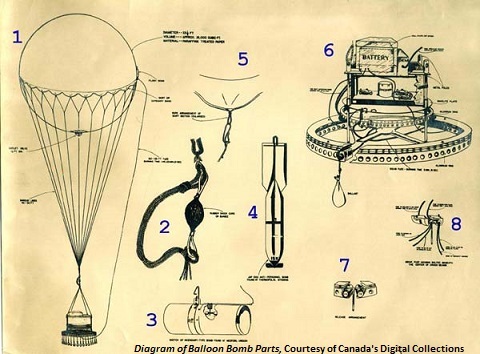Dublin Core
Title
Description
The Japanese bombing of Hawaii’s Pearl Harbor brought the United States into World War II in 1941. But one of the best-kept secrets of the War was a Japanese air offensive on the US mainland using fire balloon bombs, some of which actually reached Utah.
Starting in November 1944, Japan launched 9,000 hydrogen balloons laden with bombs that drifted in the high altitude jet stream more than 6,000 miles across the Pacific Ocean to North America. Constructed of hand-made paper and starch paste, each balloon carried a payload meant to damage cities, farms, and forests.
Of the 1000 balloons thought to have reached North America, fewer than 300 were actually sighted. Most balloons were found along the Pacific Coast and in the Intermountain West, but some traveled as far inland as Michigan. Five balloons are known to have landed in Utah, including two reported in Box Elder County, and one each in Morgan, Duchesne, and Iron Counties. Luckily these did not explode in populated areas, but Box Elder County Sheriff, Warren Hyde, did acquire a few bruises in his attempt to wrestle one balloon to the ground. The lawman got a free ride when he clung to the balloon’s ropes as it drifted and bounced him along for half a mile.
The US government prohibited the media from reporting balloon sightings in order to stem public panic and deny Japan information about the impact of their attack. The War Department feared the balloons might carry deadly diseases or even soldiers. It wasn’t until six people in Oregon were killed by one of the bombs that the government finally confirmed the existence of the fire balloons and warned people to steer clear of them.
Other than the Oregon deaths, damage from the fire balloons was minor. Discouraged by the apparent failure of the effort, Japan halted its balloon attacks in April 1945, four months before the end of the War.
Creator
Source
Image: A diagram of balloon bomb parts. Five such balloons are known to have drifted into Utah. Image courtesy Canada's Digital Collections.
_______________
“Ban Lifted on Publicity about Japanese Balloons,” Times Independent, 5/24/1945; Balloon Bombs: Japan’s Answer to Doolittle, National Museum of the Air Force, 2/4/2011; Hal Schindler, “Utah Was Spared Damage By Japan’s Floating Weapons,” Salt Lake Tribune", 5/5/1995, p A1; Salt Lake Tribune, 8/15/1945.

